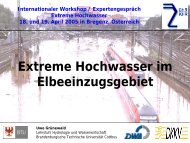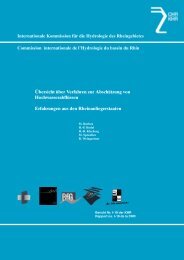ABSTRACTS 'Extreme Discharges' - CHR-KHR
ABSTRACTS 'Extreme Discharges' - CHR-KHR
ABSTRACTS 'Extreme Discharges' - CHR-KHR
You also want an ePaper? Increase the reach of your titles
YUMPU automatically turns print PDFs into web optimized ePapers that Google loves.
Using the SOBEK-model the effect of flood reduction measures in Northrhine-Westfalia was studied in combination<br />
with the effects of dike overflows. These investigations were made with the eight most extreme discharge<br />
waves, which had been calculated for Andernach. Two situations have been considered: the year 2002 and 2020,<br />
with the flood reduction measures and dike levels being realized in 2002 and 2020 respectively (for more information<br />
see Van der Veen et al., 2004a, Van der Veen et al., 2004b, Mehlig, 2004 and Lammersen, 2004).<br />
3. Results<br />
Based on the 1000 year rainfall the hydrographs with the 8 highest peak discharges were chosen. All hydrographs<br />
are different in shape and their peak discharges are cover the full range of being higher than the 1995<br />
flood, via the magnitude of discharge where the water reducing measures are working up to being higher than<br />
the design flood level. In all cases, dike overflow takes place along the Oberrhein, causing a more or less apparent<br />
damping of the floodwave at Andernach. Nevertheless they do exceed the flood levels where the dikes along<br />
the Lower Rhine are designed for. This causes inundation along the Lower Rhine, first in the southern part, later<br />
in the middle part (figure1). This is due to the growing design-flood-level along the Lower Rhine as well as to<br />
the damping of the floodwave, which is caused by the flooding upstream. The inundation of the southern and<br />
middle part of the Lower Rhine reduces the peak discharge in the northern part of the Lower Rhine and in The<br />
Netherlands. Nevertheless in present time (situation 2002) transboundary inundations can occur. By building a<br />
flood wall in Emmerich, this will be prevented in future (situation 2020).<br />
Figure 1. Flooding along the lower Rhine (situation 2002): maximum water depths [m] and main streams behind<br />
the dikes.<br />
Figure 2 shows the development of peak discharges along the Lower Rhine for two scenarios. In the first scenario<br />
calculations were done without taking into account dike overflow along the Lower Rhine. In this situation<br />
the peak discharge increases along the Rhine due to additional inflow of tributaries. Taking dike overflow into<br />
account (second scenario) the peak discharges may also decrease rapidly at certain points along the river as a<br />
result of dike overflow. In this scenario peak discharges also may rise dramatically at points where water, which<br />
is flowing parallel to the River Rhine behind the dikes, returns to the main stream.<br />
Discharge (m 3 /s)<br />
18000<br />
17000<br />
16000<br />
15000<br />
14000<br />
Peak discharge Lower Rhine<br />
Dikes infinitely high / no floodings<br />
Discharge [m 3 /s]<br />
20000<br />
18000<br />
16000<br />
14000<br />
12000<br />
10000<br />
8000<br />
6000<br />
Dikes infinitely high<br />
With dike overflow / flooding<br />
Lobith<br />
13000<br />
With dike overflow / floodings<br />
Germany<br />
NL<br />
4000<br />
2000<br />
12000<br />
620 640 660 680 700 720 740 760 780 800 820 840 860<br />
Andernach<br />
Bonn Köln Düsseldorf Ruhrort Emmerich Lobith<br />
0<br />
1995 HW1 HW2 HW3 HW4 HW5 HW6 HW7 HW8<br />
flood<br />
Figure 2. Maximum discharge with and without<br />
dike overflow (situation 2002, situation with dike<br />
overflow at the Upper Rhine, flood wave HW8).<br />
Figure 3. Peak flow at Lobith with and without<br />
dike overflow for the 1995 flood and the eight<br />
most extreme discharge waves.<br />
62





